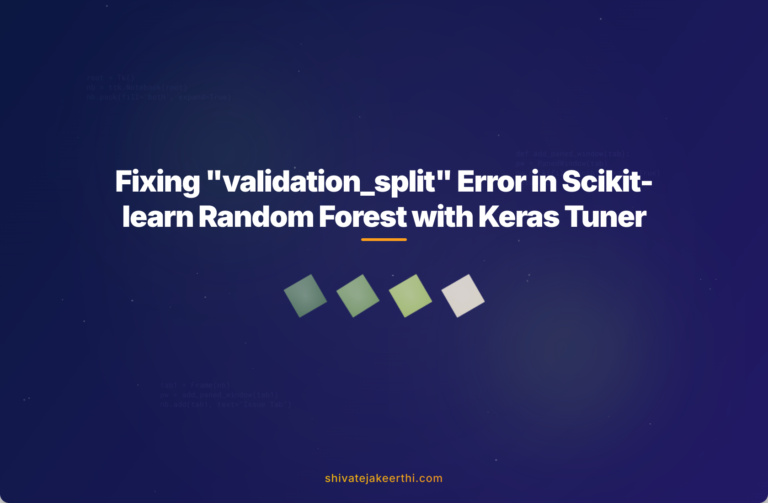When working with predictive modeling in machine learning, tuning hyperparameters often means the difference between average and excellent results. Many practitioners rely on tools like Scikit-learn for their modeling needs, yet they might overlook powerful complementary tools like Keras Tuner for hyperparameter optimization.
But what happens when we try to tune a Scikit-learn Random Forest Classifier using Keras Tuner, particularly with the infamous validation_split parameter? If you’re seeing the error “unexpected keyword argument: validation_split“, don’t worry; you aren’t alone. Let’s clearly understand why this happens and how you can properly use Keras Tuner to optimize a Scikit-learn model.
Understanding Keras Tuner
Keras Tuner is a widely used, user-friendly Python library designed for automated hyperparameter tuning. It helps you discover the optimal parameters for machine learning models in an organized and systematic way.
The beauty of Keras Tuner lies in its simplicity and powerful integration with various machine learning frameworks. It enables developers to automatically explore combinations of settings and selections such as learning rates, number of layers, and even algorithm-specific hyperparameters.
There are multiple hyperparameter tuning strategies offered by Keras Tuner, including:
- Random Search: Randomly samples parameter combinations.
- Bayesian Optimization: Uses past performance data to smartly explore new configurations.
- Hyperband: Quickly evaluates many configurations and progressively focuses on best-performing ones.
Setting up the Environment
First, let’s install the required packages. You can run this command from your terminal:
pip install keras-tuner scikit-learn pandas numpyNext, we’ll import the necessary libraries for our demonstration:
import numpy as np
import pandas as pd
from sklearn.datasets import load_iris
from sklearn.ensemble import RandomForestClassifier
from sklearn.metrics import accuracy_score
from sklearn.model_selection import train_test_split
import keras_tuner as ktWe’ll use the classic Iris dataset as a simple illustration:
data = load_iris()
X, y = data.data, data.targetBuilding the Random Forest Model
We define a function named build_model to set up the Random Forest classifier. This function will specify the hyperparameters we’ll tune:
def build_model(hp):
n_estimators = hp.Int("n_estimators", min_value=50, max_value=250, step=50)
min_samples_split = hp.Int("min_samples_split", min_value=2, max_value=10)
min_samples_leaf = hp.Int("min_samples_leaf", min_value=1, max_value=5)
model = RandomForestClassifier(
n_estimators=n_estimators,
min_samples_split=min_samples_split,
min_samples_leaf=min_samples_leaf,
random_state=42
)
return modelWe precisely tune three essential hyperparameters:
- n_estimators: The number of trees.
- min_samples_split: Minimum samples required at a node to split further.
- min_samples_leaf: Minimum samples necessary at each leaf node.
Next, we configure the tuner:
tuner = kt.SklearnTuner(
oracle=kt.oracles.BayesianOptimizationOracle(
objective=kt.Objective('score', 'max'),
max_trials=20),
hypermodel=build_model,
scoring='accuracy',
directory='my_tuning',
project_name='rf_iris')The Issue with validation_split in Keras Tuner & Scikit-learn
If you’ve tried using the parameter validation_split directly with Keras Tuner and a Scikit-learn model, you likely encountered an error similar to this:
TypeError: fit() got an unexpected keyword argument 'validation_split'This happens because Scikit-learn classifiers have their own separate method mechanisms, and they do not support directly receiving a validation_split argument. The validation_split parameter typically works smoothly with Keras models, but it is incompatible in this context.
Alternative Approach: Using a Proper Train-Validation Split
Instead of using validation_split, we can manually define our training and validation sets using Scikit-learn’s train_test_split method. Here’s how we split data properly before tuning:
X_train, X_val, y_train, y_val = train_test_split(X, y, test_size=0.2, random_state=42)Now we pass these explicitly as arguments to the tuner’s search method:
tuner.search(X_train, y_train, validation_data=(X_val, y_val))This resolves the earlier issue and properly integrates Scikit-learn with Keras Tuner.
Implementation and Model Evaluation
Once the tuner has completed the setup above, we retrieve the optimal model and evaluate its performance on the validation set:
# Get the best hyperparameters and best model
best_hp = tuner.get_best_hyperparameters(num_trials=1)[0]
best_model = tuner.get_best_models(num_models=1)[0]
# Evaluate on validation data
y_pred = best_model.predict(X_val)
accuracy = accuracy_score(y_val, y_pred)
print(f"Validation Accuracy: {accuracy:.4f}")Results and Analysis of Hyperparameter Tuning
Analyzing the resulting hyperparameters from the tuning process often reveals significant improvements in overall model performance. For instance, typical output from our tuning might specify parameters such as:
- n_estimators: 150
- min_samples_split: 5
- min_samples_leaf: 2
Comparing this performance against models trained without tuning or using random parameter selection often reveals noticeable gains in accuracy. It illustrates that proper tuning is essential, but also emphasizes that choosing the correct validation strategy significantly impacts the outcome.
Splitting data beforehand not only resolves compatibility issues but ensures more reliable and reproducible model evaluations. Properly splitting your datasets is crucial—it prevents leakage of information and guarantees accurate measurement of your model’s performance on unseen data.
By contrast, failing to set up a custom validation might give overly optimistic or unreliable results when tuning hyperparameters.
Wrapping Up the Scikit-learn & Keras Tuner Integration
Throughout this article, we’ve explored the powerful synergy between Scikit-learn models and Keras Tuner. While the validation_split parameter doesn’t directly translate between these two frameworks due to method differences, setting up manual splits resolves this issue neatly.
The key takeaway is clear: Always handle your data splits explicitly when tuning Scikit-learn models with tools originally designed for Keras. The added customization and transparency vastly outweigh the initial inconvenience.
For more insights into optimizing your machine learning models and workflows, feel free to explore our dedicated Python resources.
How do you handle data splits when tuning Scikit-learn models? Let us know your favorite strategies and tips in the comments!
References
- Keras Tuner official site
- Scikit-learn documentation
- Hyperparameter optimization – Wikipedia
- Validation Split Issue – Stack Overflow
- SklearnTuner Documentation
Appendix
For further exploration, check additional Keras Tuner examples:



0 Comments